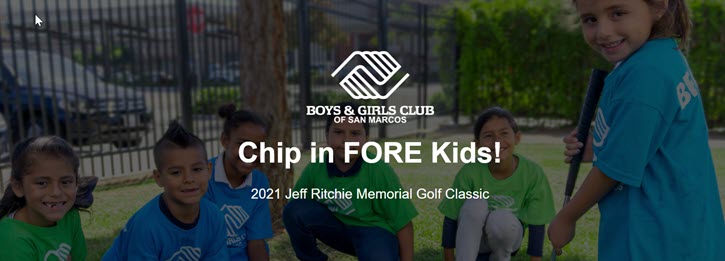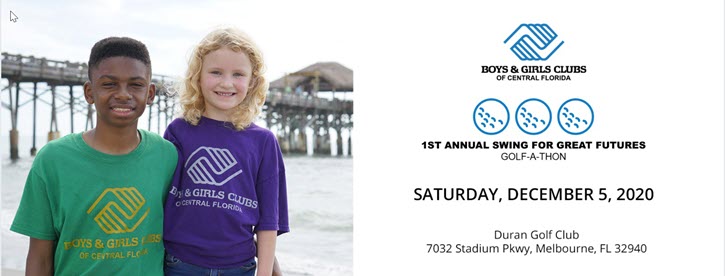There’s never been a better time to learn how to organize a golf tournament fundraiser. After all, one in three Americans over the age of 6 played, watched, or read about golf in 2019, and that number went up in 2020.
Golf has the distinction of being both a family-friendly activity and an activity that’s easy to make safe in the middle of a pandemic (yay for outdoor activities with staggered start times!). Most golf courses were lucky enough to stay open throughout 2020, making golf fundraisers a lower risk opportunity for nonprofits navigating the unknown. It’s also perfect for all ages and skill levels, meaning you can attract your regular donors and get them to bring their family and friends along for a socially distanced day out!
If you’re ready to plan your charity golf tournament, read on for tips to get you started!
1. Set a fundraising goal
When planning any fundraising campaign, the first thing you need to determine is how much you need to raise during your event. You’re 42% more likely to achieve your goals if you identify them and write them down, so start with your goal and work from there.
Once you’ve determined your overall financial goal, you can look at your average donation per person at past events to get an idea of how many attendees you’ll need to meet your goal.
2. Pick a format
Do you want to host your golf event entirely in person, or would you like to make it a virtual fundraising event?
As more and more people start to get vaccinated against COVID-19, you’ll start to see people clamoring for in-person events. However, until the vaccine rollout speeds up, some donors may still prefer virtual events.
You can easily combine both options into a hybrid event by giving golfers the option to complete the course on their own time while raising money via a peer-to-peer golf-a- thon.
If you add an auction sub-event, set it up so people can bid either in person or remotely via their computer or phone.
The most important thing to keep in mind is appealing to your donors’ preferences!
3. Find your venue
Once you’ve determined your format and number of participants, you can start looking for your venue. Golf courses are used to being asked to host charity events, but some are better equipped to hold larger crowds and hybrid events.
What’s more is that you’ll need to note each course’s COVID-19 policies so you can keep your guests safe. For instance, many courses have limited golf carts to one rider per cart, so it may make sense to change your tournament from a 4-person team tournament to a 2-person or even a single player tournament.
You can also accommodate current course requirements by offering tee times over the course of a week and tracking scoring on an app. This allows you to avoid the crowding that shotgun starts require and using a scoring app like Hole 19 eliminates another touch point for a safer event. Allowing more flexibility through tee times can also increase participation, since potential donors have more opportunities to fit your event into their schedules.
You’ll also want to consider any space you’ll need for a banquet. An outdoor banquet is still your safest option, but you’ll want to make sure your location can accommodate your guests safely in the event of inclement weather.
And whether you host your event indoors or out, you’ll want to make sure you do a test run if you plan to livestream your banquet. You don’t want to have a great experience for your in-person guests only to find out that your virtual guests gave up ten minutes in because they couldn’t hear a word!
If you’re struggling to find a great course—or running low on time—try reaching out to the coach of your local high school’s golf team. They’ll probably know which courses are best able to accommodate fundraising events.
4. Don’t just rely on donations
While Americans do love to support our favorite nonprofits (after all, 69% of us give charitably!), you don’t want to limit yourself to just donations.
Many of your supporters would be happy to buy items in support of your organization, and they’d appreciate having a souvenir to take home as well! Reusable water bottles that donors can take on the course, branded golf balls, and commemorative t-shirts are all great souvenirs that your donors would love to take home.
And if you want to make sure you raise even more, sell golf-specific extras such as mulligans (which gives participants a do over on a bad putt), super tickets (a ticket “package” that includes entry to the main event bundled with extras like raffle tickets and mulligans—it’s your “all-inclusive pass”, so to speak), and helicopter golf ball drop tickets that golfers will be excited about! What could be more fun for golfers than hanging around, seeing if their (pre-purchased) ball lands closest to the 18th hole after being dropped from an actual helicopter? The winner gets a great prize, and all your participants get some extra fun!
Don’t leave money for your organization on the table! Make sure to have at least a couple of items to sell at your event. Qgiv’s platform allows you to easily create a store to go with an auction or peer-to-peer fundraising event.
5. Look for sponsors
Hosting a great event takes money, and your organization wants to make sure donations support your mission. That’s where sponsors come in!
Just like your donors, your sponsors have many organizations they could choose to support. You’ll want to use your sponsorship request letter to explain exactly what your event is going to give back to the community.
For example, if your event is raising money for a new food storage facility that will help your food bank double the number of individuals you can help each month, then state that clearly! What business couldn’t get excited about making that big of a difference in their community?
While many companies actively look for ways to give back, don’t just tell them what your organization will get out of your fundraising efforts. Tell them what’s in it for them too!
Here are some selling points that businesses look for in sponsorship letters:
- Social media posts. Businesses—especially small, local businesses with a limited advertising budget—are always looking for ways to get their name out there in a positive way. If you have active social media accounts, tell your sponsors how you plan to promote their involvement on social media.
And be specific.
Nope : “We’ll mention you on our social media accounts.”
Yep! : “We plan on tagging sponsors in one post each on Twitter, Facebook, Instagram, and Snapchat. Sponsors will be mentioned at least five times in other event posts. Last year, event posts had a reach of 100,000.
- Website mentions. Content marketing takes work, and small businesses tend to have a very limited budget for SEO (search engine optimization). Having a sponsorship page that links back to your sponsors’ websites is both easy to do, and it adds value for your sponsors!
- Multi-channel promotions. Are you planning on sending out a press release about your event? If so, let your sponsors know in advance if you’re going to mention them! Same goes for email blasts you’re planning to send your supporters about your event, as well as any print marketing materials you plan to produce.!
- Media rights. Most people you’re asking for sponsorships have their own websites and social media accounts that they need to create content for. Granting sponsors the right to use photos, videos, and event graphics not only helps them create positive content for their audience, but it also helps you to cast an even wider net when marketing your event.
Finally, make sure to offer sponsors some fun ways to sponsor your event. Just like everyone else, they get bored receiving the same ask every single time.
For example, your sponsors could offer a matching donation (up to a certain amount) for people who hit a birdie at a certain tee or are a certain amount under par during the event. You can even host a hole-in-one competition that they can sponsor.
This keeps things more interesting for your sponsors and increases friendly competition at your event.
Even better, see if your sponsor wants to give out coupons for a certain dollar amount or percentage off to people who hit that goal. They’re more likely to get business out of your event, and it gives an extra incentive to your top participants.
Other popular alternative sponsorship options for golf-a-thons include flag pin sponsorship, technology sponsorships where a business can sponsor your livestream for a prominent “sponsored by” display throughout the livestream, and golf cart sponsorships.
6. Build your event website
Now that you have all your details planned out, you’re ready to build your event website. This doesn’t mean you need a separate website! It just means that you need a section of your website that makes getting details and registering for your fundraiser simple.
Tools like Qgiv’s auction and peer-to-peer forms make this easy, but even if you’re just adding a page to your existing website, there are some key things to keep in mind.
First, make sure your event site is branded. Donations made on a branded form average 38% larger donations than those made through a generic PayPal form. What’s more, donors are 70% more likely to make a second donation if a branded form is used!
The good news is that you don’t need to hire an expensive designer to build a branded, engaging donation form. Qgiv’s tools not only offer a way to upload your logo and a branded header with ease, but you can also edit the color scheme to match your organization’s color theme. For example, Boys & Girls Clubs chapters across the country easily tailor their forms to fit each chapter and their individual event!
You’ll also want to make sure the time and address for your event are prominent, and you’ll want to include any instructions, including details on COVID-19 safety precautions. Make sure your form and all instructions are mobile-friendly so that participants don’t accidentally miss key pieces of information!
Finally, increase your donations by offering a space for donors to add an extra donation in addition to their registration fee. You should also include prompts to ask donors to give monthly instead of just once.
7. Promote your event
Now that your event registration and donation form is set up, it’s time to promote your event! There are a few main ways you can promote your event:
- Email. Your organization likely already has supporters subscribed to an email list, and now it’s time to put this list to good use! Plan an email marketing campaign that starts with a save-the date and ends with a final thank-you email that includes a post-event survey.
If you have Qgiv’s Data package, you can further segment your list to send one message to past participants, and one to those who are new attendees!
You can also use emails to announce sponsors; send out teasers for any sale, raffle, or auction items; and solicit volunteers for your event.
- Text marketing. Text marketing is still vastly underutilized despite having a 98% open rate. You can not only send out an event announcement that links to your online registration form, but you can also use texting to motivate volunteers and peer-to-peer recipients.
With Qgiv, you can set up separate lists for each group of people you need to contact. Just make sure you have permission before signing up contacts for text message marketing!
You can also use texting to increase donations during your event. Make sure to advertise your campaign keyword and short code (numbers your guests can text) clearly throughout your event so participants can donate as they play!
- Print materials. Creating flyers, posters, and banners for your event is still a great way to raise awareness of your event. After all, many local businesses are more than happy to let you post a flyer in the window if it’s for a good cause.
Print materials also offer a unique sponsorship opportunity, as you can reach out to a local printing and graphic design company to see if they would be willing to sponsor your event by providing your print materials!
- Press releases. While most nonprofits don’t have a budget to have a dedicated public relations person on staff, any talented writer on staff can learn to write press releases for your nonprofit!
Once your press release is written and approved, you can send it to the media and reach out to local bloggers and influencers to see if they’d be willing to promote your event.
- Social media. There are endless things you can do to promote your event on social media, from setting up a Facebook event to using video to tease auction items or prizes for top performers. The important thing to remember is to produce different types of content to keep your audience engaged, and don’t over-post (you don’t need to post about your event every single day on social media).
And—as important as it is for you to share your event on social media—it’s even more important for you to make it easier for your guests to share it. The easiest way to do this is to make sure social sharing is set up on your event registration page. Social integration is included with all Qgiv packages, even at the Start level! See which fundraising package will work best for your event by signing up for a demo!
Social media is also a great tool to use during your event, especially if you’ve converted to a hybrid or virtual fundraising event. For example, if you host a golf-a-thon where you give participants a window (say, a week) to complete the course on their own time, you can then host the awards banquet using Facebook Live or YouTube Live.
Both tools are user-friendly and can allow you to get even more participants involved. For example, not everyone may want to golf, but they may be interested in participating in a silent auction or raffle!
8. During your fundraising event
It’s important to have a clear plan of what needs to happen during your event, from layout to staff assignments.
You can help yourself by making sure you and all participating staff have a detailed schedule that lists everything from when the caterers arrive to what time you expect to be done with cleanup. You should also include who the point person will be for each part of your event, so staff and volunteers know who to go to if something’s wrong.
You also want to include prompts for donation and space for impact videos in your schedule.
Since most events are planned very far in advance, you’ll also want to have a contingency plan written out so guests and staff alike will know what to do in case of inclement weather or other unexpected circumstances.
Finally, make it easy for your guests to stay engaged during your event with a Fundraising Hub. Fundraising Hubs are included with Qgiv Peer-to-Peer and Auction packages, and you can use them to further encourage donations by using the text-to- donate prompt mentioned above. You can also display a leaderboard that shows top participants, sponsor information, and the classic, but effective, fundraising thermometer.
Fundraising Hubs can also be updated in real time, making them a great place to highlight recent donors.
9. After your event
Just because your event is over doesn’t mean your work is done! After all, you still need to thank your donors. If you used the Qgiv platform, your donors have already received a thank-you for signing up, donating, or making a purchase in the store.
Hopefully, you’ve customized those thank-you emails based on how the donor contributed (did they choose to honor a loved one, cover the processing fees, etc.?)!
But now that your event is over, you still need to send another thank-you. In this thank-you, tell your supporters how much you were able to raise with their help, and explain how these funds will help the community. If your event raised funds for a bigger project—like a new building—you can send progress reports so your participants can see the results of their efforts as time goes on.
You should also include a survey in your post-event email to get ideas on how your event succeeded, and what you may want to do differently next year.
10. Get ready for next year
Once the event is over, it’s time to take a quick breath… and get started planning for next year! Even if you don’t have active preparations to do, now is the perfect time to evaluate those participant surveys and see what changes you may need to make to create a more engaging fundraiser next year.
It’s also time to compare your event to the previous year’s event to see what worked and what didn’t. Did your social media posts get less engagement over time? Maybe you were posting too frequently. Did you raise more or less than last year? What changed?
There are infinite ways to make your fundraising data work for you, and after the event is the perfect time to go through it.
Similarly, now is also a great time to go through all photos and videos from this year’s event to pick the best ones. You’ll be able to use these images to help promote next year’s event, and you don’t want to have to hunt them down when the next event rolls around!
Conclusion
Golf events are a fun, family-friendly way to raise funds for your nonprofit, even in the middle of a pandemic. We hope the above tips showed you how to organize a golf tournament fundraiser for your organization. You can also check out the Hybrid Events Guide for more ideas on converting your golf-a-thon into a combined in-person and virtual event.
Looking to upgrade your next fundraising event with an award-winning event and fundraising platform? Schedule a demo to learn more about how Qgiv’s fundraising platform can help you take your forms to the next level!











